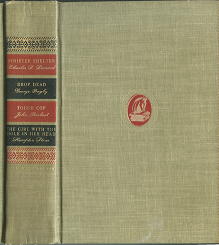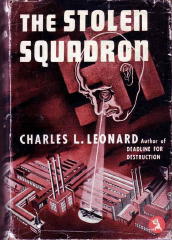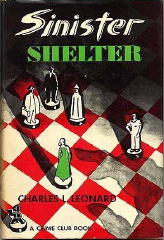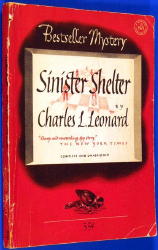Fri 4 Jul 2008
Archived Review: CHARLES L. LEONARD – Sinister Shelter.
Posted by Steve under Authors , Bibliographies, Lists & Checklists , Reviews[2] Comments
CHARLES L. LEONARD – Sinister Shelter.
Unicorn Book Club; reprint edition. Originally published by Doubleday Crime Club, 1949. Digest paperback reprint: Bestseller Mystery B141. Pulp magazine reprint: Two Complete Detective Books, May 1950 (probably abridged).
One way you can read mystery and detective novels from the late 1940s and early 50s, if you can’t come across them in any other way, is to find them in hardcover book club editions, either from the three-in-one Detective Book Club, or the four-in-one volumes that came from the Unicorn Mystery Book Club.

Of the two, the Unicorn Books were classier in appearance, and they look very handsome on the bookshelf. They didn’t last nearly as long as their competitors, however, including of course the Dollar Mystery Guild, which eventually came along. (And still is going strong today, although you can certainly forget the dollar part of their name.)
In any case, without going further into their history (for now), I just bought about 20 of the Unicorn books on eBay, and over the next few weeks I’m planning on using them for reading material. Whether I skip around or read whole volumes at a time, I haven’t decided, but if it makes any difference, I think I’ll try reading this particular grouping all the way through. Stay tuned.
In real life Charles L. Leonard, author of eleven private eye Paul Kilgerrin novels, of which this one, was M. V. Heberden, who also wrote two other series of PI novels under that name, one featuring Desmond Shannon (17 books), the other being Rick Vanner, who appeared in three.
I’m not sure when the secret came out, but I imagine some eyebrows were raised when the initials M. V. were revealed to stand for Mary Violet. It’s been a while since I read any of them, but what little bibliographic information is about her books on the Internet suggests that they were tough, rugged and a little hard-boiled, reminiscent not at all of “shrinking violets.”
While nominally a private eye, in this particular book Kilgerrin given an assignment by the government to help stop a flood of illegal immigrants from coming into the US after World War II. And from the list of titles he appeared in, he seems have been an undercover spy much more often than he worked out of an office where good-looking women who came in were apt to be his clients.
Here’s a list of the Kilgerrin books. I think you’ll come to the same conclusion as I did. (All of the books were first published in hardcover by Doubleday Crime Club.)
The Stolen Squadron (1942)

The Fanatic of Fez (1943)
Secret of the Spa (1944)
Expert in Murder (1945)
Pursuit in Peru (1946)
Search for a Scientist (1947)
The Fourth Funeral (1948)
Sinister Shelter (1949)
Secrets for Sale (1950)
Treachery in Trieste (1951)
Not that there aren’t good-looking women involved, at least in Sinister Shelter. While he is working undercover to get a line on the people smugglers, Kilgerrin befriends the members of a refugee family who are trying to make their way into the United States via Argentina.

Among them is a young widow and her young boy who are living with her husband’s parent, said husband having disappeared after being arrested by the Nazis some time before. Kilgerrin is kind and gentle with the family, especially with Irma, and if he is hard-boiled about some other things, with her he does not seem to be.
The essence and general ambiance reminded me more of Hammett than it did Chandler, and for a long time, it was difficult to understand why. (I’ll return to this later.) Kilgerrin works with a firm goal in mind, but he has the capability of being able to improvise quickly, such as when the elderly father meets someone the family had known well back in Austria.
Marie Louise, now Louise Ritter, is the other woman in the story, and while her strong, enigmatic presence shifts the story quickly into second gear, it will occur to more than one reader, I am sure, that while coincidences like this often happen in the real world, fiction is never quite that strange.
In a way, there is a morality play going on. How does one comport oneself in the face of tyranny, the elderly father wonders on page 121, one man, acting alone, against evil? Kilgerrin himself tries to be understanding with Irma, but often finds himself frustrated when she cannot forget the past, when it stays with her and she cannot free herself from it.

The puzzle presented by the novel’s other lady of mystery gradually absorbs more and more of his attention. Kilgerrin has more in common with Louise Ritter, and he soon realizes it, making the question of how deeply she is involved with the smuggling gang all the more a matter of importance. (This could have been handled, unfortunately, somewhat more eptly.)
They are two entirely different women, and to Kilgerrin each is a mystery in different ways. The scene in which he last sees Irma is when (for me) the Hammett-Chandler comparison suddenly snaps into focus.
There is very little action, surprisingly enough, until the end. Character studies need some patience on the part of their readers, and that’s what, in large part, this story is comprised of. On the other hand, just to be sure that you know there is one, I’m going to quote the last few lines of the book, at which point in time the primary antagonist has been identified and is being discussed.
I’ve tried to be very careful in setting this up properly. If I’ve done it correctly, this will demonstrate, more than anything else, that there’s more involved here than character studies.
Kilgerrin shook his head. “When anyone with that much guts goes wrong, he or she has got to be killed,” he said.
[UPDATE] 07-04-08. Since I don’t imagine you can make them out in the small image shown, the other three books in the same Unicorn volume as this one are: Drop Dead, by George Bagby; Tough Cop, by John Roeburt; and The Girl with the Hole in Her Head, by Hampton Stone.
In spite of the promise I made in the course of this review, I never did get around to reading any of these. On the other hand, the book is still here on the table next to the computer and keyboard where I’m typing away. That must mean something, mustn’t it?
The other reason, of course, for retrieving this review from the archives, is the preceding post, the “mystery author” turning out to be Mary Heberden, aka M. V. Heberden, aka Charles L. Leonard. More on her shortly, I hope — what little is known about her so far.
January 24th, 2009 at 4:00 pm
Though he is described as an insurace investigator, Paul Killgerrin works mostly as a counterspy, often on loan to the government, in all the Leonard books I’ve read, and from the titles I would guess all the one’s in print. James Sandoe picked two Killgerrin adventures for his famous list of notable hard-boiled tales, and with some justification (Sinister Squadron and Secrets of the Spa).
Killgerrin is clearly in the Hammett tradition, and reading his adventures I’m always reminded of the scene when the Op muses how much he’d like to be on a roof with a .50 cal. machine gun whenever he sees a mob. The only difference is Killgerrin wouldn’t just talk about doing it. In almost every one I’ve read Killgerrin doesn’t hesitate to kill to bring about a succeesful end to his case. All the more surprising since Leonard was M. V. Heberden, a woman.
I can testify that all the Killgerrin books I’ve read are quite good, and most of the Heberden titles about Desmond Shannon and Rick Vallin too. For some reason many of the Shannon and Vanner books have South American settings. They aren’t quite as ruthless as Killgerrin, but they come close. If you like your hard-boiled eggs of the over three minute variety you should check these out. In addition the lady could write and plot, and so far I haven’t found a disapointing entry. I prefer the Killgerin books written as by Leonard, but the Heberden books are good too, though Shannon and Vanner can be a bit sour tempered at times. There weren’t a lot of women in the hard-boiled genre at the time she was writing, but Heberden certainly should hold a high place among the ones who did work in the field. Some of the books were reprinted in paperback in the eighties and not too hard to find.
January 18th, 2011 at 6:57 pm
[…] review of Sinister Shelter, a later Kilgerrin novel (1949), appears here on this blog, along with a list of all eleven of his adventures. Preceding that is a post […]